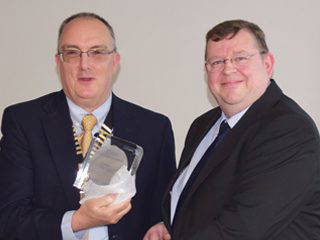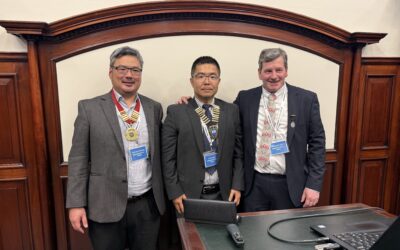CED Working Day and Symposium on ‘Knowledge Transfer and the Management of Infrastructure Corrosion’
This one-day meeting, held on 27 April at the National Railway Museum, York, is the latest in a series of working days of the CED. There were five main talks after which the meeting broke up into the individual working groups. It was also possible for participants to visit the National Railway Museum.
Nick Smart (Jacobs), Chair of CED, welcomed delegates to the meeting and introduced the speakers. He is stepping down as chairman after 15 years and introduced the new chairman, Danny Burkle. The meeting showed their appreciation for Nick’s excellent efforts during that time and welcomed the new chair.
The first presentation was given by Desmond Makepeace (Galvanizers Association) on ‘Hot dip galvanizing for specification and use in infrastructure projects. Desmond started by describing the galvanising process, and noted the appropriate standard is EN ISO 1461. A variety of defects were discussed. However, it was pointed out that the coating does not have to be perfectly smooth, a certain number of defects can be tolerated, e.g. yellow-orange flux staining, wet storage stains, colour variation, zinc ash, zinc build-up and entrained dross. Other factors affecting the quality of galvanizing were discussed: coating thickness, renovation, adhesion, joining-bolting, duplex systems, maintenance, venting of hollow sections, and overlapping sections. He also discussed how the atmosphere affects corrosion of galvanised structures.
The Young ICorr talk, ‘Best management practices to transfer knowledge to ensure integrity assurance optimisation for oil and gas production’ was given by Izabela Gajewska (Intertek). Knowledge transfer may be defined as, ‘A method of sharing information across different areas in the business’ or ‘A process by which experienced employees share or distribute their knowledge’. In order to address this process, a good plan is needed, which should include work experience, mentoring, training, e-learning, attending conferences, text books, and standards. For best results, a mentor specific to the work situation is required, meeting the ‘student’ weekly or twice monthly, in-person or on-line. The candidate should be furnished with a tailored curriculum and encouraged to give PowerPoint presentations, such as happens with, ‘learn at lunchtime’ talks. External training courses should include subjects such as, basic corrosion, welding, materials, coating, fire protection, cathodic protection, chemical treatments and risk assessments.
Chris Atkins (Mott MacDonald) presented his thoughts on the consequences of climate change on corrosion. He pointed out that historically established corrosion rates in any given environment may no longer be valid, due to the emissions of carbon dioxide that are taking place. The increase in atmospheric carbon dioxide is likely to reduce the pH of natural waters, making them more aggressive to concrete. It will also increase carbonation of concrete, but on the plus side, it may reduce the corrosion rate of galvanized steel. The recognised temperature increase reduces the dissolved oxygen content in water, and Chris showed how an increase in temperature does not automatically produce an increase in corrosion rates. Certainly, any reduction in carbon dioxide levels is likely to reduce atmospheric corrosivity. Chris highlighted that, as far as he is aware, no one is taking an overarching view on the effect of climate change on corrosion, and this could be an opportunity for the Institute to take a leading role.
Richard Barker (Leeds University) addressed the subject of, ‘Academia and industry: How can we advance corrosion science and engineering together?’ It used to be said, ‘academics want to publish and companies want to make money’. However, when research has both scientific and commercial potential, collaboration can be mutually beneficial. Academics have time and research resources and produce new knowledge, and firms are well-placed to commercialise this. However, academia and industry have very different operating environments. Two barriers arise: complexity of communication (knowledge exchange/dissemination) and the complexity of physical collaboration (joint projects). Academic literature tends to be complex, vast and continually changing. To overcome this, industry must trust scientists. Richard pointed out that some companies go to great lengths to identify trusted scientists and research groups. It was concluded that there are significant benefits in collaboration between academia and industry, challenges exist but they can be overcome with the correct approach from both sides.
The President then presented the Paul McIntyre Award to Chris Lynch, Engineering Manager at Corrpro Companies, Europe. Chris received the award for his outstanding contribution to a number of aspects of corrosion engineering over a number of years and particularly his work in advancing standards in the area of cathodic protection and supporting the Institute’s training activities (see below).
After lunch, Nick Smart (Jacobs) gave a presentation on, ‘Radioactive waste disposal – where corrosion science meets corrosion engineering’. He elucidated the three main levels of waste. High (HLW), comprising spent fuel/liquid waste which was usually vitrified before being placed in stainless steel containers, Intermediate (ILW), including graphite, waste sludge and structural components, and Low (LLW), of very low radioactivity (e.g. paper, plastics). He described a number of corrosion science research projects that have supported the corrosion engineering and safety assessment aspects of radioactive waste management. Corrosion issues include atmospheric external corrosion of stainless steel waste containers during interim storage, the corrosion behaviour of waste uranium, aluminium and Magnox after encapsulation in cement, and the long-term corrosion of waste containers after disposal in deep geological conditions. The UK total waste inventory has a volume of approximately 4,500,000 m3, which would fill Wembley Stadium! (fortunately, only 0.02% being HLW). The two main concepts for the geological disposal of HLW involve placing copper or carbon steel canisters deep underground and surrounding them with a ‘buffer’ material to prevent release of radionuclides to the biosphere, such as bentonite clay, which swells and provides compressive forces around copper-based containers, or a cementitious buffer material, which provides a highly alkaline environment that reduces the corrosion rate of carbon steel to very low values (<0.01 µm yr-1). Possible geological disposal environments around the world include sedimentary clay, crystalline granite or salt evaporite, with each potential site having different groundwater compositions. Key environmental factors are oxygen concentration, chloride and sulphide concentrations, radiation levels and microbial activity. Nick highlighted the use of a range of analytical techniques to characterise the corrosion behaviour and corrosion rates of candidate waste container materials in long-term in situ experiments conducted under representative conditions. Such studies can be supported by comparison with the corrosion of natural analogues, such as archaeological artefacts, for example the Coppergate Helmet, an 8th century Anglo Saxon helmet made from iron and copper, currently exhibited in the Yorkshire Museum.
This session finished with a short talk by Stuart Bond from AMPP who discussed and highlighted the revised standards development activities carried out by AMPP (a merger between SSPC/NACE was rolled out in January 2021).
The above talks are available in pdf form through the ICorr website in the CED section of the members’ area.
The meeting then split up into the working party section and, apart from the concrete group, all held meetings, short summaries of these follow:
Nuclear Corrosion Group
Following on from Nick Smart’s talk on the interface between corrosion engineering and corrosion science in the context of radioactive waste management, the nuclear corrosion working group, chaired by Nick Smart, held a small meeting which had a wide-ranging discussion about corrosion issues arising during the storage of nuclear waste. These included assessment of pitting corrosion in stainless steel during storage in atmospheric conditions, the effects of microbial corrosion on cast iron under damp conditions, and the potential for galvanic corrosion of stainless steel in contact with graphite in cementitious environments.
Coatings Group
The meeting, chaired by Phillip Watkinson (PW), had seven participants. The minutes of the last meeting in April 2021 were read and approved. The coatings Technical Information Documents (CTID), created in 2016-17, are now due for review. These comprise, Inspection and Testing of Coatings, Surface Preparation Methods, Paint Definition and Generic Organic Coating Types, Thermal Spraying, and On-site and Off-site Application of Intumescent Fire and Corrosion Protective Coatings for Steel Structures. NACE Coatings standards have been transferred to AMPP. G. Maltman pointed out that, as a result of climate change, 15 years standard atmospheric corrosion tests may have to be amended due to changes in RH, rainfall, temperature etc. Douglas Mills (DJM) suggested that EIS measurements (ISO 12944) be reviewed. PW tabled two standards on Paints and Varnishes (BS EN ISO 4628-1: 2003 and 4628-2:2003) also requiring review. Finally, DJM suggested that an interim meeting (possibly via ZOOM) be held ahead of the next annual CED Working Day. This was agreed by the meeting.
Cathodic Protection Group
Chris Lynch was acting chairman of the CP group on the day. In a small meeting, discussion centred on subsea CP systems and performance of flush fit aluminium deep sea anodes on complex piping systems. This included current distribution, current density, anode installation methodology and expected performance along with coatings, anode corrosion products and calcareous deposits.
All Energy Group
This group with Steve Paterson as the chair arose from the Oil and Gas group, with renewable energies now included. This was its first meeting under the new name. Nine people attended. The minutes of the previous Oil and Gas meeting were accepted, although none of the actions had been able to be completed. A good discussion was had (which all those present contributed to) about the purpose of the working group. This covered 1) production of documents (several of the old TACC documents were being revised), 2) Mentoring of young ICorr members, 3) Information exchange via networking, and 4) engagement with other organisations like AMPP. There was also a standards update. It was agreed (as with the coatings group) to try to hold an update Zoom meeting in October.

The delegates.
Nick Smart chaired the closing discussions and thanked the speakers, the Institute of Corrosion, the delegates for attending and the National Railway Museum for providing their excellent facilities. As mentioned at the start Nick is retiring from the CED chair position. And so it is over to Danny, to sort out next year’s meeting. Watch this space!
Report by David Nuttall and Douglas Mills
Personal comments from
Nick Smart.
It has been an interesting and rewarding experience for me to be chair of CED for about 15 years. We have held meetings in many venues that I would never have visited otherwise and met many people outside my normal field of work. I am particularly grateful to Douglas Mills, who has helped me in the role. I would also like to thank the working group chairs who have volunteered their time and the many invited speakers (over 60), who have agreed to give a wide range of interesting talks. There is an archive of previous CED talks given in the members’ area of the Institute’s website. A highlight of my term in office was the initiation in 2017 of the Paul McIntyre Award, which is the first Institute award that specifically recognises the achievements of corrosion engineers, rather than corrosion scientists. The CED continues to provide a valuable way of networking between professionals in the corrosion engineering field and of involving up and coming corrosion engineers.
National Railway Museum.

Chris being presented with the award from the President.



